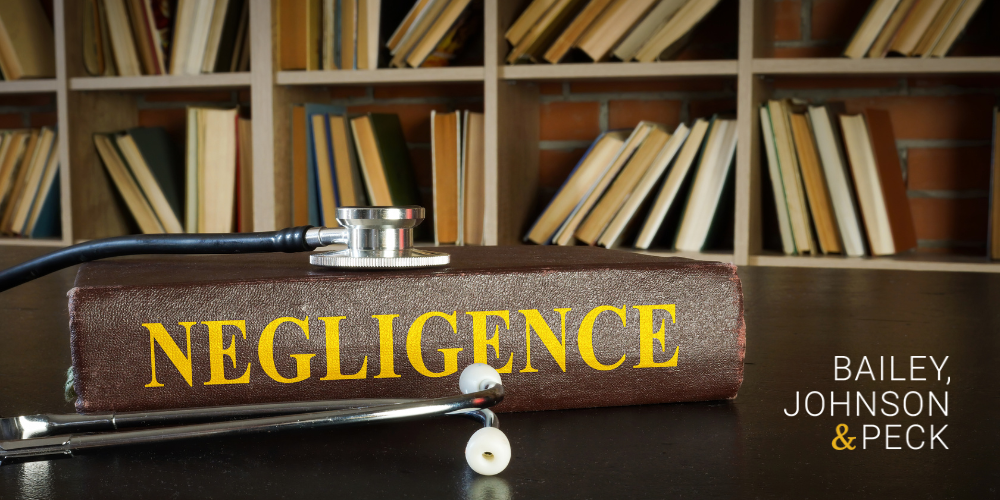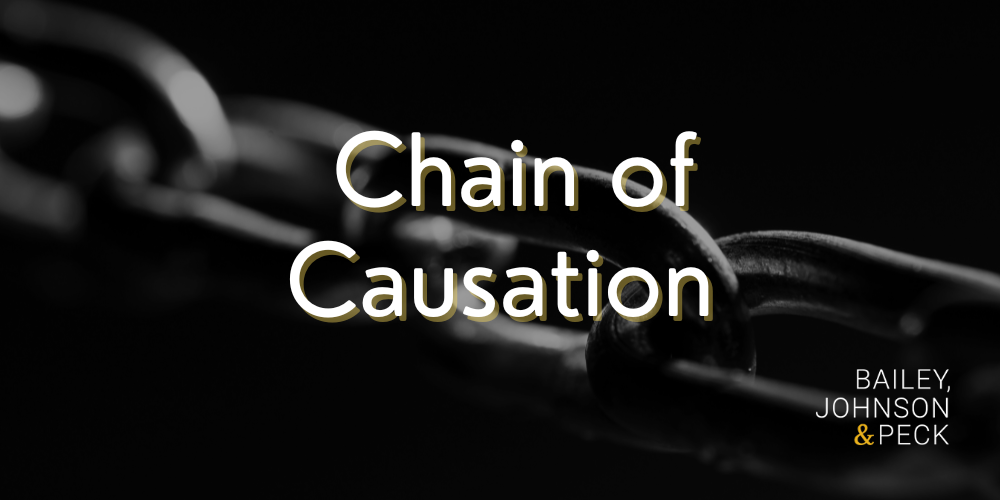The chain of causation is an essential legal concept that Bailey, Johnson, & Peck, P.C. rigorously applies to establish liability in personal injury cases involving negligence. This legal causation chain involves delineating a clear, unbroken sequence of events—a causal relationship—between the defendant’s actions (cause in fact) and the actual injury sustained (proximate causation). By methodically proving each link in the chain of causation, from the initial negligent act to the reasonable foreseeability of harm, our Albany personal injury attorneys ensure that all elements of tort liability are addressed.
Our personal injury law firm assesses contributory negligence, examines intervening causes, and evaluates the extent of damages to craft a compelling negligence claim for our clients. Mastery of the chain of causation and the implications of legal causation allows us to effectively advocate for the full compensation our clients deserve, thereby upholding the integrity of the legal process and ensuring justice in Albany’s courts.
If you believe you have a personal injury claim, call Bailey, Johnson & Peck today at 518-456-0082 to schedule a free consultation.
What is Negligence in a Personal Injury Case?
Negligence is the cornerstone of every personal injury case. A negligence claim could include instances such as:
- Car Accidents: Drivers who engage in reckless behaviors such as a driver running a red light, passing railroad guards, speeding, texting and driving, ignoring traffic laws, or drinking and driving are valid reasons for a negligence claim if the negligent driver caused an accident. Our Albany car accident attorneys have extensive experience with car accident cases and can help prove negligence if you were involved in a collision that wasn’t your fault.
- Medical Negligence: Medical professionals have a legal duty towards their patients. Misdiagnosis, surgical errors, medication mistakes, or failure to provide appropriate treatment can result in injuries to patients. If a doctor acted negligently and caused serious injuries, an Albany medical malpractice lawyer or an Albany misdiagnosis lawyer can help ensure the physician is held responsible for this breach of duty.
- Premises Liability: Property owners have a responsibility to maintain a safe environment for visitors. Premises liability cases can arise when property owners fail to address hazards. Contact an Albany slip and fall lawyer or an Albany premises liability defense attorney for more information.
- Dog Attacks: Dog attacks are often a result of the owner’s negligence in controlling their pet. If a dog owner fails to properly restrain dog and it attacks someone, this is a direct cause of the injury, and they may be held liable for the injuries inflicted. Our Albany dog bite lawyers can help you obtain the compensation you need to recover.
Whether it’s a reckless driver, doctor, dog, or property owner, proving that someone’s failure to meet the expected standard of care led to your injury is essential in tort law.

What Are the Four Elements of Negligence?
To establish a negligence case, four main elements must be proven:
Duty of Care
The first link in the chain of causation is the duty of care. This involves demonstrating that the defendant owed a duty of care to the injured party. In other words, the defendant had a legal obligation to act reasonably to prevent injury to others.
Breached Duty of Care
The second element in the chain of causation is the breach of duty of care. This breach of duty requires showing that the defendant failed to act in a way that meets the standard of care expected in the given situation. Proving that a person breached their duty of care to the plaintiff is a key aspect of successful negligence cases.
Causation
The third element in the chain of causation is causation. Legal causation connects the defendant’s breach of duty to the plaintiff’s injuries. It establishes that the defendant’s actions (or inaction) directly caused the personal injury.
Damages
The fourth element in the chain of causation is damages. The injured person must establish that they suffered actual injuries or losses as a result of the defendant’s negligence. For example, this can involve medical bills, pain and suffering, lost wages, and other quantifiable losses.
What is the Chain of Causation?
The chain of causation is a crucial concept in tort law and even criminal law, representing the intricate link between a defendant and the injured party. Understanding the chain of causation is vital to prove negligence in court.
As previously explained, this chain of causation consists of several elements, including duty of care, breached duty of care, causation, and damages. Causation, in particular, is a pivotal element, as it directly connects the defendant’s negligent act to the plaintiff’s injuries. Understanding and demonstrating this cause-and-effect relationship is often challenging but essential for a successful personal injury case.
The chain of causation serves as the linchpin that holds the negligence claim together, allowing personal injury victims to seek compensation for his or her injuries.

Cause in Fact vs Proximate Cause
Cause in Fact
Actual cause – also known as “cause in fact” or factual cause – is a critical component within the chain of causation. It addresses the fundamental question of whether the defendant’s act or inaction was the direct cause of the plaintiff’s injuries. In essence, actual cause seeks to establish a direct link between the negligent act and the injuries suffered by the plaintiff. The “but for” test is often employed to prove factual causation, which asks whether the plaintiff’s injury would have occurred “but for” the defendant’s action.
Proximate Cause
Proximate causation, also known as legal cause, delves deeper into the consequences of the defendant’s actions in cases involving negligence.
It evaluates whether the defendant’s negligence was the appropriate legal cause of the plaintiff’s injuries, considering the reasonable foreseeability of the consequences.
Defining proximate causation involves a nuanced analysis, considering whether the injury was a natural and foreseeable result of the defendant’s action or inaction. It’s important to note that while the defendant’s actions may be an actual cause, they may not always be a proximate cause if the resulting harm was not foreseeable or occurred through an intervening event that was not within the defendant’s control.
Proximate cause safeguards against holding parties responsible for outcomes that were too remote or lacked reasonable foreseeability, ensuring that liability is justly assigned in personal injury cases.
“But For” Causation Test
The “But For” test is a fundamental principle within the chain of causation in personal injury law. This test serves as a litmus test to determine the actual cause of an injury. It asks a straightforward yet pivotal question: “But for” the defendant’s negligent actions, would the plaintiff’s injuries have occurred?
If it can be established that the injuries in question would not have transpired without the defendant’s conduct, then the “But For” test supports the argument that the defendant’s actions were the actual cause of the injury.
Substantial Factor Test
The substantial factor test is crucial in personal injury law for determining liability, especially for cases involving multiple causes contributing to an accident or injury. This test helps determine whether the defendant was a significant factor in the chain of causation. If the defendant’s conduct significantly contributed to the injury, despite other contributing factors, they can be held liable. However, if an intervening act is significant enough to be considered breaking the chain of causation, it can diminish the impact of the defendant’s fault, and the defendant cannot be liable in court by law.
Superseding Cause
The chain of causation links must be proven elements of negligence showing that the defendant caused the accident or injuries. Breaking the chain of causation means that something is broken between one of the elements of negligence. There’s a disruption. If the chain of causation is interrupted, the defendant cannot be held liable.
Keeping the chain of causation unbroken depends on foreseeability, which is why foreseeability in negligence is crucial to hold someone liable.
The chain of causation can be broken when a superseding cause, otherwise termed an intervening cause, breaks the causation chain or chain of cause-and-effect. Breaking the chain of causation can only occur when the superseding cause isn’t reasonably foreseeable.

What Does the Reasonable Person Standard Impose on a Person in a Negligence Lawsuit?
In a negligence lawsuit, the reasonable person standard imposes a crucial test for determining liability and holding a defendant liable for damages if deemed responsible. This reasonable foreseeability doctrine assesses whether the act in question constitutes a breach of the duty of care that a hypothetical person would have exercised under a similar situation or circumstances.
Central to this is the concept of reasonable foreseeability, which evaluates whether a reasonable person could have anticipated the occurrence of harm as a result of their actions. The outcome of this assessment is critical in establishing a chain of causation: if the chain is broken, the defendant may not be held liable. However, if the chain of causation does not break, it is established that the act was sufficient to lead to the harm foreseeably, all other elements of negligence are involved, and the defendant may indeed be held accountable for the action.
This reasonable foreseeability standard promotes accountability by mandating a uniform threshold of precaution and consideration others might reasonably expect in similar circumstances.
Types of Evidence That Can Prove Causation in a Personal Injury Case
Proving causation in a personal injury claim often requires several types of evidence used to hold the defendant liable for injury or death, including:
- Medical Records: Medical records can provide a clear link between the defendant’s actions and the plaintiff’s injuries by documenting the extent and nature of the harm.
- Expert Testimony: Expert witnesses, such as medical professionals or accident reconstruction specialists, can provide opinions on causation and foreseeable danger based on their expertise.
- Eyewitness Accounts: Eyewitnesses who observed the incident can offer valuable testimony regarding the sequence of events leading to the injury.
- Surveillance Footage: Video evidence from security cameras or other sources can provide visual proof of how the accident occurred.
- Documentation and Records: Documents, such as accident reports, maintenance logs, or communication records, can help establish causation by revealing negligence or unsafe practices regarding reasonably foreseeable danger.
Albany Personal Injury Attorneys
If you have suffered severe injuries and financial loss due to someone else’s negligence, you may have grounds to file a claim and recover damages. Albany personal injury attorneys at Bailey, Johnson & Peck have decades of combined experience in proving the chain of causation in many types of injury claims, including car accident cases, medical negligence cases, premises liability cases, and more. Our dedicated team of injury attorneys is ready to advocate for your rights and help you secure the compensation you deserve for your injuries and losses. Call Bailey, Johnson & Peck at 518-456-0082 to schedule a free consultation and begin your journey towards justice and recovery.




